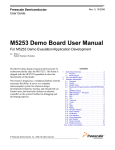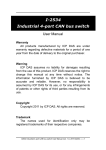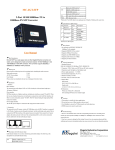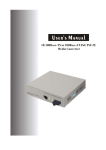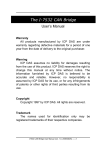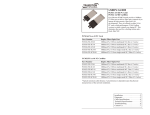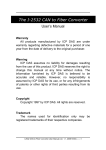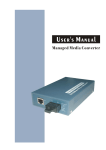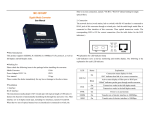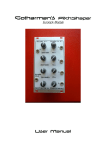Download I-2532 User Manual
Transcript
The I-2533 CAN to Fiber Bridge User Manual Warranty All products manufactured by ICP DAS are under warranty regarding defective materials for a period of one year from the date of delivery to the original purchaser. Warning ICP DAS assumes no liability for damages resulting from the use of this product. ICP DAS reserves the right to change this manual at any time without notice. The information furnished by ICP DAS is believed to be accurate and reliable. However, no responsibility is assumed by ICP DAS for its use, or for any infringements of patents or other rights of third parties resulting from its use. Copyright Copyright 1997 by ICP DAS. All rights are reserved. Trademark The names used for identification only may be registered trademarks of their respective companies. I-2533 CAN to Fiber Bridge User Manual (ver. 1.0, 2010/01/07) ------1 Tables of Content Tables of Content...........................................................................................2 1 Introduction.............................................................................................3 1.1 Specifications ................................................................................4 1.2 Features..........................................................................................5 2 Technical data .........................................................................................6 2.1 Block Diagram................................................................................6 2.2 Appearance ....................................................................................7 2.3 Pin Assignment..............................................................................8 2.4 Rotary Switch .................................................................................9 2.5 LED Indicator ...............................................................................10 2.6 Terminator Resistor Setup .......................................................... 11 2.7 Wire Connection ..........................................................................13 3 Network Deployment ............................................................................14 3.1 Driving Capability ........................................................................14 3.2 Fiber Selection & Fiber Length...................................................15 3.3 Filter & User-defined Baud Rate Configuration ........................16 4 Dimension .............................................................................................22 I-2533 CAN to Fiber Bridge User Manual (ver. 1.0, 2010/01/07) ------2 1 Introduction I-2533 is a local CAN bridge used to establish a connection between two CAN bus system via fiber optic transmission medium. In order to solve the problem between CAN and fiber transmission medium, I-2533 is specially designed for converting the electrical CAN bus signal to fiber optic cables. Not just like I-2533, I-2533 has three more important features. First, the transmission distance limitation of the CAN bus system will not reduced because of CAN baud rate. It means that the total network distance can be extended. Second, the bus error on one CAN network will not affect the operation of another CAN network. Finally, the two CAN network can communication with each other by using different CAN baud rate for highly flexibility. Besides, I-2533 provides the utility tool for user-defined baud rate and filter configuration. By using this tool, it is allowed to have user-defined baud rate and message filter. When users use the I-2533 on two CAN network with different CAN baud rate, it may be useful to reduce the bus loading on the network which has low baud rate. I-2533 CAN to Fiber Bridge User Manual (ver. 1.0, 2010/01/07) ------3 1.1 Specifications CAN Interface Connector Baud Rate (bps) Transmission Distance (m) Isolation Terminator Resistor Specification Fiber Interface Connector Wave Length Fiber Cable Transmission Distance (m) UART Interface COM 1 COM 1 Connector Baud Rate (bps) Data bit Stop bit Parity LED Round LED Power Power supply Protection Power Consumption Mechanism Installation Dimensions Environment Operating Temp. Storage Temp. Humidity Screwed terminal block (CAN_GND, CAN_L, CAN_H) 10 k ~ 1 M Depend on baud rate 2500 Vrms Switch for 120Ω terminator resistor ISO-11898-2, CAN 2.0A and CAN 2.0B ST (Multi-mode) 850 nm 50 / 125 μm , 62.5 / 125 μm, 100 / 140 μm (62.5 / 125μm is recommended) 2 km max (in 62.5 / 125 μm fiber cable) RS-232 (configuration only) Screwed terminal block (RxD, TxD, GND) 115200 8 1 None PWR LED, CAN_Tx LED, CAN_Rx LED, CAN_Err LED, FB_Err LED Unregulated +10 ~ +30 VDC Power reverse polarity protection, brown-out protection 3W Over-voltage DIN-Rail 32.3mm x 77.5mm x 99.0mm (W x L x H) -25 ~ 75 ℃ -40 ~ 80 ℃ 5 ~ 95% RH, non-condensing I-2533 CAN to Fiber Bridge User Manual (ver. 1.0, 2010/01/07) ------4 1.2 Features z z z z z z z z z z z z z Fiber Port: ST (Multi-mode) Maximum transmission distance up to 2 km at any CAN baud rate 82C250 CAN transceiver 2500 Vrms isolation on the CAN side Support both CAN 2.0A and CAN 2.0B Fully compatible with the ISO 11898-2 standard Rotary switch for CAN baud rate configuration Build-in switch for 120 Ω terminator resistor Up to 100 CAN nodes on each channel Removable terminal block, Mount easily on DIN-Rail Allow user-defined baud rate Fiber broken line detection Utility tool for message filter configuration I-2533 CAN to Fiber Bridge User Manual (ver. 1.0, 2010/01/07) ------5 2 Technical data 2.1 Block Diagram The following figure is the block diagram illustrating the functions of the I-2533 module. Figure 2-1 Block Diagram of I-2533 I-2533 CAN to Fiber Bridge User Manual (ver. 1.0, 2010/01/07) ------6 2.2 Appearance Rotary Switch 0~9: Default baud rate A: User-defined baud rate B~E: N/A F: Utility configuration Front View Bottom View LED Indicators Fiber Port Connector Type: ST Wavelength: 850nm Fiber Type: Multi-Mode, 50/125μm, 62.5/125μm, 100/140μm COM Port Only for utility tool COM Port ISO 11898-2 standard Power Connector +10 ~ +30VDC between +VS and GND DIP Switch Enable or disable 120Ω terminator resistor Figure 2-2 Appearance of I-2533 I-2533 CAN to Fiber Bridge User Manual (ver. 1.0, 2010/01/07) ------7 2.3 Pin Assignment The pin assignments of COM port, CAN port, fiber port and power connector of I-2533 are shown in the following tables. Table 2-1 Pin Assignment Port COM CAN Fiber Power Name Description TXD TXD pin of RS-232 port. RXD RXD pin of RS-232 port. GND SG (or GND) pin of RS-232 port. CAN_L CAN_Low, signal line of CAN port. CAN_H CAN_High, signal line of CAN port. CAN_GND CAN_Ground, ground voltage level of CAN port. TXD Transmit optic data. RXD Receive optic data. +VS Voltage Source Input. +10VDC ~ +30V VDC. GND Power Ground. F.G. Frame Ground. Sometimes, the CAN_GND voltage level of different CAN devices on a CAN bus system are not equal. In this case, it could cause some problems and derogate the system stability. There is one way to relieve this situation; users can connect the CAN_GND of different CAN devices with each other to balance the voltage level of CAN_GND. Electronic circuits are always influenced by different levels of Electro-Static Discharge (ESD), which become worse in a continental climate area. F.G. provides a path for conducting the ESD to the earth ground. Therefore, connecting the F.G correctly can enhance the capability of the ESD protection and improve the module’s reliability. Wiring of CAN_GND and F.G. is not necessary; users can modify the configuration of wiring according to real applications. I-2533 CAN to Fiber Bridge User Manual (ver. 1.0, 2010/01/07) ------8 2.4 Rotary Switch When users would like to set the CAN baud rate or message filter of I-2533, use the rotary swich on the upper of the power connector to archieve this purpose. Users can find it on the top of the power connector. 2 6 E A BC D 345 Rotary switch for CAN baud rate Figure 2-3 Location of Rotary Switch There are 16 sections on the rotary switch. They are descripted on the following table. Table 2-2 Description of Rotary Switch Switch Value Description 0 Set baud rate to 10 kbps 1 Set baud rate to 20 kbps 2 Set baud rate to 50 kbps 3 Set baud rate to 80 kbps 4 Set baud rate to 100 kbps 5 Set baud rate to 125 kbps 6 Set baud rate to 250 kbps 7 Set baud rate to 500 kbps 8 Set baud rate to 800 kbps 9 Set baud rate to 1 Mbps A Set baud rate to user-defined baud rate which is configured by I-2533 utility. B~E F Not-available Set I-2533 into configuration mode. I-2533 CAN to Fiber Bridge User Manual (ver. 1.0, 2010/01/07) ------9 2.5 LED Indicator There are 5 LEDs on the I-2533. One for power indication, three for CAN bus indication and one for fiber indication. The LED assignment and description are shown as follows. Figure 2-4 LED Assignment of I-2533 LED Name Color PWR Red Description When power on the I-2533, this LED is turned on. CAN_Tx Green When I-2533 sends one CAN message to CAN bus, this LED flashes once. Therefore, if bus loading is heavy, the LED will be always on. CAN_Rx Green When I-2533 receives one CAN message from CAN bus, this LED flashes once. Therefore, if bus loading is heavy, the LED will be always on. CAN Err Red 1. If I-2533 detects the bus-off status on the CAN bus, this LED is always on. 2. If I-2533 can’t send CAN messages successfully because the bus connector is off or some errors happen, this LED flashes five times per second. 3. If the CAN data buffer is full, this LED flashes once per second. Fiber Err Red 1. If the I-2533 detects the RXD line of the fiber is off, this LED is always on. 2. If the fiber data buffer is full, this LED flashes once per second. Table 2-3 LED Description I-2533 CAN to Fiber Bridge User Manual (ver. 1.0, 2010/01/07) ------10 2.6 Terminator Resistor Setup In order to minimize the reflection effects on the CAN bus line, the CAN bus line has to be terminated at both ends by two terminator resistors as in the following figure. According to the ISO 11898-2 spec, each terminator resistor is 120Ω (or between 108Ω~132Ω). The bus topology and the positions of these terminator resistors are shown as following figure. Device 1 Device 2 Device N 120Ω 120Ω CAN_H CAN_L Figure 2.5 CAN bus network topology Each I-2533 includes one build-in 120Ω termintor resistor, users can decide if it is enabled or not. The DIP switch for terminator resistor is under the power connector. 2 6 E A BC D 345 DIP switch for terminator resistor Figure 2-6 Location of Terminator Resistor DIP Switch The following DIP switch statuses present the condition if the terminator resistor is active (default) or inactive. I-2533 CAN to Fiber Bridge User Manual (ver. 1.0, 2010/01/07) ------11 Figure 2-7 Adjustment of Terminal Resistance Generally, if your application is as follows, we recommend you to enable the terminator resistor. 120Ω 120Ω Figure 2-8 Application 1 If your application is like the structure as follows, the terminator resistor is not needed. CAN_H CAN_L Device 1 Device 2 I-2533 Device N Fiber Device 1 Device 2 I-2533 Device N CAN_H CAN_L Figure 2-9 Application 2 I-2533 CAN to Fiber Bridge User Manual (ver. 1.0, 2010/01/07) ------12 2.7 Wire Connection The wire connection of I-2533 is displayed below. Fiber Port Tx Tx Rx Rx +10VDC ~ +30VDC CAN_GND CAN_GND Power GND CAN_H CAN_H Power GND CAN_L CAN_L Earth Earth Power Port +10VDC ~ +30VDC CAN Port (ISO 11898-2) Figure 2-10 Wire Connection of I-2533 Interconnecting The I-2533 has a metallic board attached to the back of the plastic basket. This metallic board and the F.G. pin of power connector are interconnected inside the I-2533. When users mount the I-2533 onto a metal DIN-Rail, users can connect the DIN-Rail to Earth Ground to replace connecting the F.G. pin of power connector. Figure 2-11 Metallic Board at Back of I-2533 I-2533 CAN to Fiber Bridge User Manual (ver. 1.0, 2010/01/07) ------13 3 Network Deployment 3.1 Driving Capability Before introducing the driving capability of I-2533, some characteristics of copper cable must be assumed. The AC parameters are 120Ω impedance and 5 ns/m line delay, and the DC parameter follows the table shown below. Table 3-1 Recommended DC parameters for CAN Bus Line Wire Cross-Section [mm2] Resistance [Ω/km] ~0.25 (AWG23) < 90 ~0.5 (AWG20) < 50 ~0.8 (AWG18) < 33 ~1.3 (AWG16) < 20 Under the conditions described above, users can refer to the following table to know the maximum node numbers in each segment following ISO 11898-2 and the maximum segment length when using different type of wire. Table 3-2 Driving Capability Wire CrossSection [mm2] The maximum segment length [m] under the case of specific node number in this segment 16 Nodes 32 Nodes 64 Nodes 100 Nodes ~0.25 (AWG23) < 220 < 200 < 170 < 150 ~0.5 (AWG20) < 390 < 360 < 310 < 270 ~0.8 (AWG18) < 590 < 550 < 470 < 410 ~1.3 (AWG16) < 980 < 900 < 780 < 670 I-2533 CAN to Fiber Bridge User Manual (ver. 1.0, 2010/01/07) ------14 3.2 Fiber Selection & Fiber Length The specification of fiber used to connect I-2533 is shown as following table. Table 3-3 Specification of Fiber Type Diameter [μm] (Core/Cladding) Operating Wavelength [nm] Multi-Mode 50/125 62.5/125 100/140 850 I-2533 allows maximum 2 km fiber length for each kind of CAN baud. Alought the maximum fiber length has no relationship with the CAN baud rate, but the some attributions of fiber still influence it. Higher attenuation of fiber will reduce the transmission distance. Users can use following table to know the relationship between those two. Table 3-4 The relationship between CAN baud rate and ideal fiber length CAN Baud Rate [bit/sec] 1 M ~ 10 k Ideal Fiber Length [m] 2000 Table 3-5 Attenuation & Fiber Length Attenuation [dB/km] Fiber Length [m] 2.8 < 2000 4 < 1500 By the way, when users use I-2533 in their application, they need to use one pair of I-2533 for communication. The general application architecture may look like as follows. Figure 3-1 I-2533 general application architecture I-2533 CAN to Fiber Bridge User Manual (ver. 1.0, 2010/01/07) ------15 3.3 Filter & User-defined Baud Rate Configuration When users want to use user-defined baud rate or set the message filter, I-2533 utility tool may be needed. It can be free downloaded from the following web site or get it in the product CD (path: CAN\Converter\I-2533\): http://www.icpdas.com/products/Remote_IO/can_bus/i-2533.htm After getting the utility tool, please follow the following steps to set the baud rate and message filter. 67 BCD 01 EF 2 8 9A Step0: Power off the I-2533. Set the rotary switch to “F”, and connect the PC available COM port with the COM port of the I-2533. Users can find the communication cable in the product box. When connecting to the COM port of I-2533, the TxD pin of the cable is connected to the TXD pin of the COM port, RXD pin of the cable is connected to the RXD pin of the COM port, and GND pin of the cable is connected to the GND pin of the COM port. Then, power on the I-2533. COM TXD TXD RXD RXD GND GND 34 5 N/A N/A CAN_L CAN_H CAN_GND Step1: Execute the I2533_Utility.exe, the dialog of the I-2533 Utility will be poped up. Select the PC COM port which is connected with the COM port of the I-2533. Then, click “Connect” button. I-2533 CAN to Fiber Bridge User Manual (ver. 1.0, 2010/01/07) ------16 Step2: After connecting the I-2533 successfully, the parameters stored in the I-2533 will be shown on the dialog. Step3: Users can set the baud rate on the “User-defined Baud Rate” field. Here, fill “250000” for 250 kbps. Then, set the filter by using the “from” field, “to” field, and “Add” button. For example, If users want to pass the CAN message with ID 0x4 and 0x5 in the CAN 2.0A specification. Fill the value “4” in the “from” field of CAN 2.0A, and the value “5” in the “to” field of CAN 2.0A. I-2533 CAN to Fiber Bridge User Manual (ver. 1.0, 2010/01/07) ------17 Step4: Click “Add” button to add this configuration. The configuration is shown on the “Pass List” field. If the “Pass List” is not empty, only the messages matched with the “Pass List” will be passed. If the “Pass List” filed is empty, it means all-pass. If users want to pass the message with ID 0x0 in the CAN 2.0A specification, fill the value “0” in both of “from” and “to” field and click “Add” button. Step5:.The method of configuring the message filter of the CAN 2.0B messages is similar with the configuration steps of the message filter of the CAN 2.0A messages. After finishing all of the configurations, click “Save all configuration” to store the configuration in the I-2533. I-2533 CAN to Fiber Bridge User Manual (ver. 1.0, 2010/01/07) ------18 Step6: When the procedure is successful, the following message will be shown. Step7: Then, Users can save the configurations in to an .ini file. Click “Save to File” to archieve this purpose. I-2533 CAN to Fiber Bridge User Manual (ver. 1.0, 2010/01/07) ------19 Step8: Of course, users can load the configurations from .ini file, and store them into the I-2533. Step9: If users want to recover the configurations to be default, click “Factory Default” and “Save All Configuration” button. I-2533 CAN to Fiber Bridge User Manual (ver. 1.0, 2010/01/07) ------20 Step10: Selecting one filter form the “Pass List” and clicking “Delete one” button can remove one setting. For example, if users want to remote the setting of ID 0x018 from the CAN 2.0A Pass List, click the ID 0x018 in the “Pass List”, and click “Delete one” button. The ID 0x018 will be removed from the “Pass List”. “Clear all” button will remove all settings from the “Pass List”. Step11. After finishing the configuration, set the rotary switch value to “0” ~ “A” and reboot the I-2533. The CAN message filter will be applied automatically in the value “0” ~ “A” of the rotary switch. The CAN baud rate set by utility is only appled when the rotary switch is set to “A”. I-2533 CAN to Fiber Bridge User Manual (ver. 1.0, 2010/01/07) ------21 4 Dimension Figure 4-1 Dimension of I-2533 I-2533 CAN to Fiber Bridge User Manual (ver. 1.0, 2010/01/07) ------22























